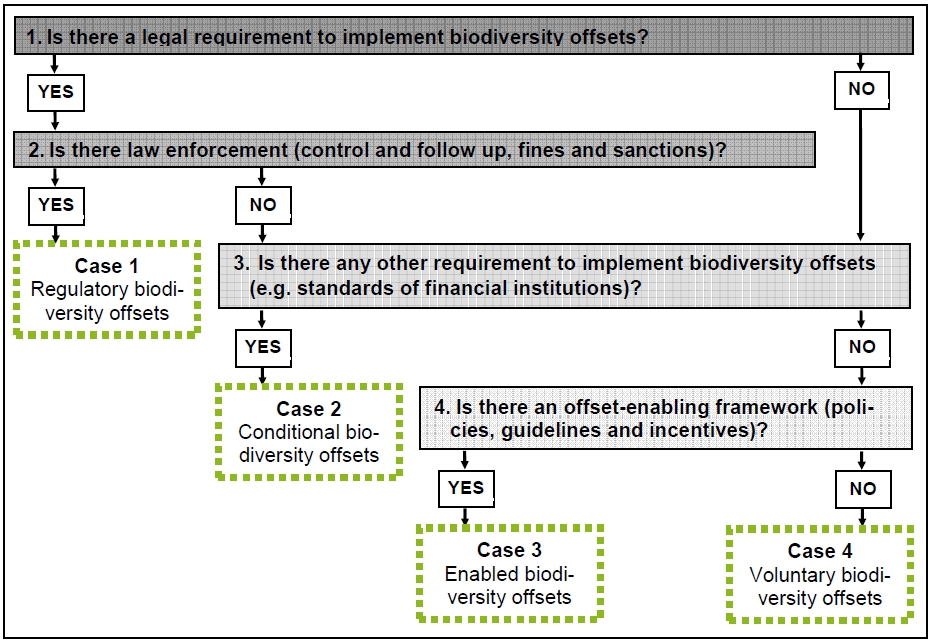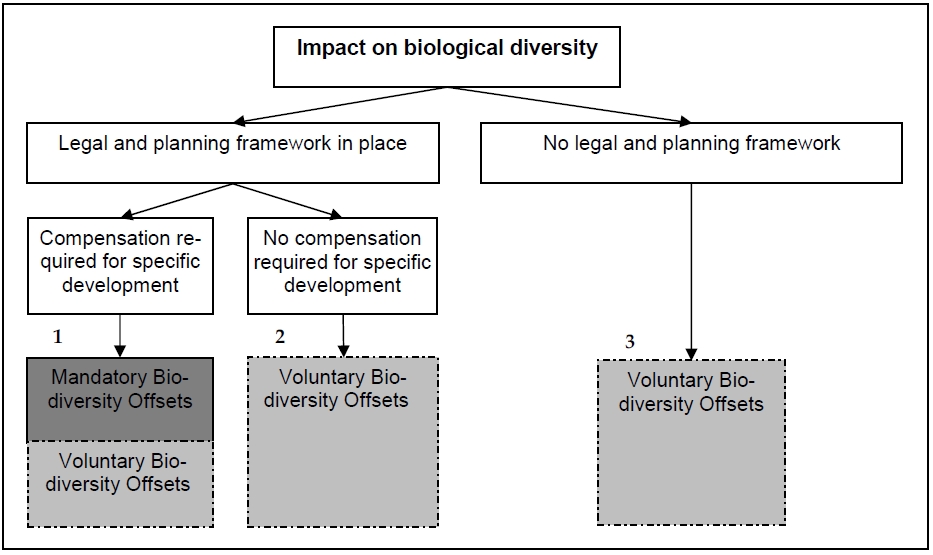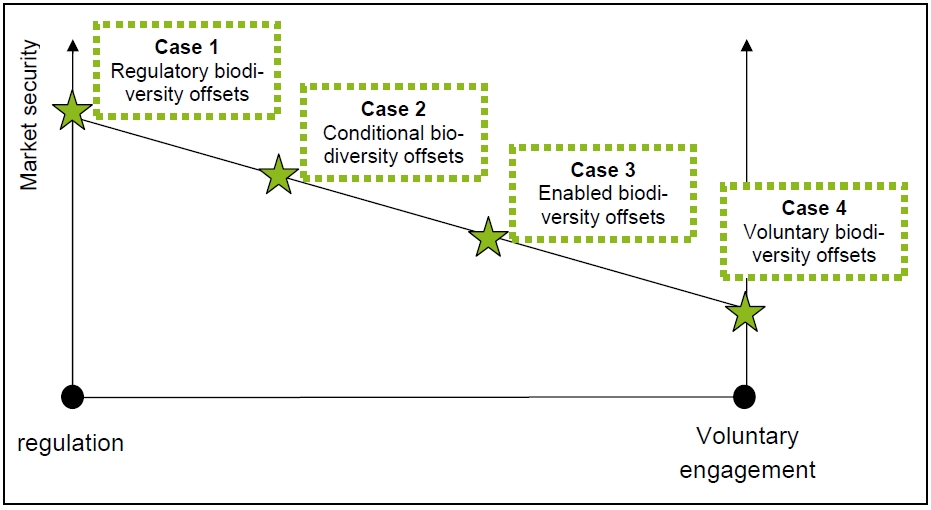Inspired by the multitude of biodiversity offsetting approaches worldwide, the inherent complexity of the concept of biodiversity offsets and the growing information overload, I have been interested in the distinction between regulatory and voluntary offsetting schemes since 2009. However, as I realized, these are not two distinct categories (“black and white”) but instead represent the two ends of a continuum. I have made this interesting field the research subject of my PhD and am working out a typology of biodiversity offsets with regard to the degree of voluntariness. This is an early draft on a Typology of Biodiversity Offsets.
I have been interested in the distinction between regulatory and voluntary offsetting schemes since 2009. However, as I realized, these are not two distinct categories (“black and white”) but instead represent the two ends of a continuum. I have made this interesting field the research subject of my PhD and am working out a typology of biodiversity offsets with regard to the degree of voluntariness. This is an early draft on a Typology of Biodiversity Offsets.
Typology of Biodiversity Offsets between two poles: Mandatory Biodiversity Offsets vs. Voluntary Biodiversity Offsets
A general distinction can be made between two types of offsets (as outlined in the research proposal): on the one hand Mandatory Biodiversity Offsets are required by legal and planning provisions and on the other hand Voluntary Biodiversity Offsets can either exceed these requirements or exist completely independent from them. [Darbi 2010a and b] This distinction of two kinds of biodiversity offsets is underlined by BBOP as follows: (a) Voluntary biodiversity offsets, which a developer undertakes in circumstances where there is no legal requirement to do so, because it perceives a business advantage (such as license to operate, reputational benefits, competitive advantage, market share, etc); or (b) Regulatory biodiversity offsets, which are required by law. [BBOP Secretariat 2010]
Figure 1 illustrates in which cases Voluntary Biodiversity Offsets may emerge. They are especially important where the legal basis and general guidance are lacking. However, Voluntary Biodiversity Offsets have also been noted as complements to mandatory approaches in some cases.
Fig. 1: Mandatory Biodiversity Offsets and Voluntary Biodiversity Offsets [Darbi 2010a and b]
Typology of Biodiversity Offsets in a continuum: cascade of Biodiversity Offsets
However, the distinction into two categories is rather simplified and doesn’t represent the actual practice. Instead, there is a whole range of biodiversity offsets between two poles: a high degree of regulations on the one side and a high voluntary engagement on the other. Therefore, in order to understand why biodiversity offsets are implemented a number of questions need to be asked. Figure 2 suggests a cascade of four questions leading to a set of four biodiversity offset categories (to be examined and further supplemented):
- Case 1 Regulatory biodiversity offsets: The question whether a legal requirement to offset exists is alone not sufficient. As has been seen mandatory or “regulatory” biodiversity offsets only exist if there is law enforcement.
- Case 2 Conditional biodiversity offsets: Beside the legal obligation, there may be other requirements that, while not being mandatory, make biodiversity offsets a condition when the project proponent wants to obtain for example financial support (e.g. Performance Standards 6 of the International Finance Corporation IFC). Even though he is not obliged to do so, the project proponent will have to comply with these standards and implement biodiversity offsets (which from a business point of view usually will be a better way than losing the financial support).
- Case 3 Enabled biodiversity offsets: Even if there is no kind of legal or other requirement present there may still be an “offset-friendly” environment. An offset-enabling framework may include policies, guidelines and all forms of incentives from public authorities and civil society.
- Case 4 Voluntary biodiversity offsets: In contrast to regulatory biodiversity offsets pure voluntary biodiversity offsets emerge and are qualified as such when neither any forms of requirements nor incentives exist.
Fig. 2: Cascade of biodiversity offsets (draft)
Other aspects for the Typology of Biodiversity Offsets
Nevertheless, the suggested classification hasn’t taken into consideration a number of aspects, in particular temporal aspects, the role of stakeholders and the institutional context and the discrepancy between the one who is responsible to offset and the one who implements biodiversity offsets.
With regard to temporal aspects it is important to note that offsetting schemes usually are dynamic systems that undergo changes. This is in particular true for voluntary compensation schemes. This can be illustrated at the example of the Malua BioBank in Sabah (Malaysia). Initiated as a credit-based voluntary certification system set up as a cooperation of the Forestry Department, Sabah and (public authority) and New Forests (a private timberland investment management company with a focus on sustainable forestry and emerging environmental markets), the biobank now implements biodiversity offsets. To date all is on voluntary basis but establishing a mandatory regulatory framework is being discussed. A general recommendation of a recently held workshop was to go towards making offsets and no net loss mandatory with a voluntary trial period. [personal communication with Fred Kugan and Darius Sarshar, 2010]
Another Case is that of a gold mine in Ghana (operated by Newmont Mining Corporation). The mining company had set out a plan to implement voluntary biodiversity offsets. Through the inclusion of this plan in the Environmental Impact Assessment and the approval procedure this initial voluntary engagement was converted into a legal permit requirement. [personal communication with Nana Adunsiah, 2010]
Generally, in addition to the two cited examples, it is not seldom that new offset regulations emerge or existing ones are enforced. In such cases voluntary biodiversity offsets are likely to be (anticipatory) “pre-compliance measures” [personal communication with Nathaniel Carroll, 2010]
Typology of Biodiversity Offsets with regard to the market opportunities
As previously mentioned there is often a discrepancy between a project proponent who is responsible for the negative environmental impacts of his activities and a third party who implements biodiversity offsets (compensation services provider). According to the “polluter pays principle”, generally the project proponent is liable for the damages caused by the project, and has therefore to put in place appropriate compensation measures. Nevertheless, the development and implementation of offsets can be carried out either on a project-by-project basis, i.e. by the project proponent providing actions and measures, or devolved to a third party [Escorcio Bezerra 2007]. The latter includes mitigation banks (e.g. US Wetland Mitigation Banking), conservation banks, in-lieu fee arrangements, auction and brokering schemes (Darbi et al. 2009).
Third party approaches could be sub-divided in banking frameworks and in-lieu arrangements. Banking frameworks are those schemes in which entrepreneurs, by developing their own offset initiatives can earn credits and then recapture their investment by selling these credits to project developers with offset obligations. [Escorcio Bezerra 2007]
This shift of responsibility from the project proponent to a third party is particularly important for voluntary biodiversity offsets. A clear distinction between the responsibility and motivation of the project proponent on the one side and the compensation services provider on the other side has to be made. For compensation services providers biodiversity offsets represent a market opportunity. Figure 3 illustrates that the market security is higher in regulatory biodiversity offset schemes than for voluntary approaches (due to the fact that voluntary biodiversity offsets are often implemented on a case-by-case basis and the demand is thus difficult to estimate in advance).
Fig. 3: Market opportunity for biodiversity offsets
References
BBOP Secretariat (2010): Biodiversity Offsets: A tool for CBD Parties to consider and a briefing on the Business and Biodiversity Offsets Programme (BBOP), Draft, unpublished.
Darbi, M (2010a): Biodiversity Offsets – a tool for environmental management and biodiversity conservation. In: In: Sanchez Bengoa, D.; Powell, D. (Eds.) : TOP Biodiversity 2010. Intercollege-Larnaca, Cyprus. Conference Proceedings. Larnaca : Intercollege-Larnaca, 2010, S.289–301.
Darbi, M (2010b) Voluntary Biodiversity Offsets: Freiwillige Kompensationsmaßnahmen für Eingriffe in die Biodiversität – eine neue Perspektive für den Erhalt und die Wiederherstellung der biologischen Vielfalt weltweit und in Deutschland? In: Feit, U.; Korn, H. (Bearb.): Treffpunkt Biologische Vielfalt IX — Interdisziplinärer Forschungsaustausch im Rahmen des Übereinkommens über die biologische Vielfalt. BfN, Bonn. S. 199–204
Darbi, M.; Ohlenburg, H.; Herberg, A.; Wende, W., Skambracks, D. & Herbert, M. (2009), International Approaches to Compensation for Impacts on Biological Diversity. Final Report. Im Internet: http://www.forest-trends.org/biodiversityoffsetprogram/library/new/Bio-kom_Final %20Report_IOER_TUB.pdf.
Escorcio Bezerra, L G (2007): Biodiversity Offsets in National (Brazil) and Regional (EU) Mandatory Arrangements: Towards an International Regime? http://www.forest-trends.org/biodiversityoffsetprogram/library/new/Dissertation%20Biodiversity%20Offsets%20LGB%20IUCN%20BBOP.doc



Pingback: Biodiversity Offsets need a strong regulatory system! Or voluntary engagement? - Biodiversity Offsets Blog